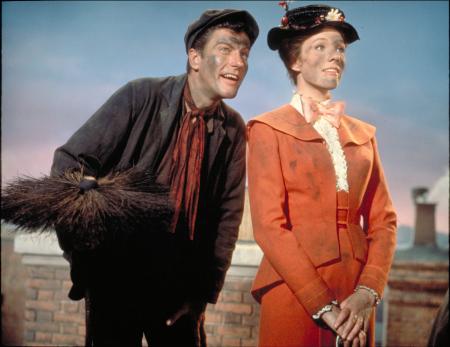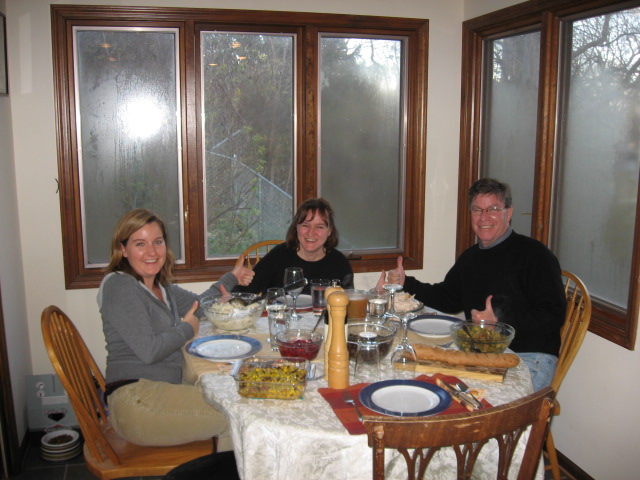The Brits apparently don’t like data when it comes to cooking hamburgers, and now, turkey.
Same with the Irish.
For the home cook, the data is the tip-sensitive digital thermometer, and a recording of 160F for hamburgers, 165F for poultry.
For the U.K.’s Food Standards Agency, it’s, "check it’s piping hot all the way through."
 I have no idea what that means.
I have no idea what that means.
When I hear piping hot, I think of Dick van Dyke in Mary Poppins.
Seriously, the best the taxpayer-funded FSA can come up with is:
So make sure your turkey is cooked properly:
* check it’s piping hot all the way through
* cut into the thickest part to check that none of the meat is pink
* if juices run out, they should be clear.
Wow.
One of the great things about the barfblog software provided by food safety dude Bill Marler is that we can see what people are searching for. Since Thanksgiving, people are repeatedly searching for, "Where to place a thermometer in a turkey."
So, not only are they using a thermometer, they want to know how to do it properly.
Don’t ask the U.K.’s Food Standards Agency.
Or Ireland’s safefood, which yesterday said it’s safe to cook stuffing inside the turkey and,
"remember, always make sure your cooked turkey is piping hot all the way through, with no pink meat, and all the juices run clear."
But here are some tips. And some pics from our Thanksgiving turkey.
 Food safety guru Pete Snyder says,
Food safety guru Pete Snyder says,
If you have stuffed the turkey, you must cook the stuffed bird until the stuffing is above 150F. This assures a 10,000,000-to-1 kill of Salmonella. At this point, the breast will probably be 165F, which is very safe, and the thigh will be about 185F, which is necessary to make this muscle tissue soft.
Sara Moulton on ABC’s Good Morning America says:
The thermometer goes into the thickest part of the thigh and should not touch the bone.
The U.S. National Turkey Federation says to insert the thermometer 2 1/2 inches in the deepest portion of the turkey breast or into the inner thigh near the breast. Make sure the thermometer does not touch a bone. When inserting the thermometer in the turkey breast, insert it from the side. The thermometer is easier to read and more accurate than when inserted from the top.
 And the U.S. Department of Agriculture says for whole turkeys, place the thermometer in the thickest part of the inner thigh. Once the thigh has reached 165 °F, check the wing and the thickest part of the breast to ensure the turkey has reached a safe minimum internal temperature of 165 °F throughout the product.
And the U.S. Department of Agriculture says for whole turkeys, place the thermometer in the thickest part of the inner thigh. Once the thigh has reached 165 °F, check the wing and the thickest part of the breast to ensure the turkey has reached a safe minimum internal temperature of 165 °F throughout the product.
The Brits are right to say that people shouldn’t wash their turkeys before cooking them — a cross contamination nightmare — but why they refuse to advocate tip-sensitive digital thermometers is baffling. And risky.
And these are happy people not barfing because I used a tip-sensitive digital meat thermometer, and didn’t rely on "piping hot."

.jpg)

 After 12 hours of preparation and baking, the 134-pound burger emerged Saturday at Mallie’s Sports Bar and Grill.
After 12 hours of preparation and baking, the 134-pound burger emerged Saturday at Mallie’s Sports Bar and Grill..jpg)
.jpeg) There’s nothing glorious about salmonella.
There’s nothing glorious about salmonella..jpg)
.jpeg)

.jpg)
 I have no idea what that means.
I have no idea what that means. Food safety guru
Food safety guru  And the
And the 

 We had our first, monthly, Food Science Café, last night, and while numbers were small, I still believe that, if you build it, they will come.
We had our first, monthly, Food Science Café, last night, and while numbers were small, I still believe that, if you build it, they will come..jpg) "Lots of people use it for whole birds or roasts, but I think it’s more important actually for the burgers and the ground beef," Powell said. "Ten years ago I would have never used one, but now I feel naked when I don’t – I feel vulnerable."
"Lots of people use it for whole birds or roasts, but I think it’s more important actually for the burgers and the ground beef," Powell said. "Ten years ago I would have never used one, but now I feel naked when I don’t – I feel vulnerable." This is a ConAgra Banquet turkey pot pie Amy and I purchased the evening of Oct. 9, 2007 and kept in the freezer. It had the P-9 code on the side — the
This is a ConAgra Banquet turkey pot pie Amy and I purchased the evening of Oct. 9, 2007 and kept in the freezer. It had the P-9 code on the side — the 




 I eat the pot pie.
I eat the pot pie. Almost two weeks ago
Almost two weeks ago  Does the chicken in this picture look cooked to you? Color is a lousy indicator of the doneness of chicken. The pictured chicken comes from
Does the chicken in this picture look cooked to you? Color is a lousy indicator of the doneness of chicken. The pictured chicken comes from